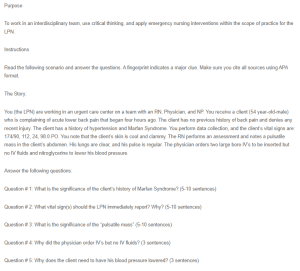Aortic Aneurysm Case Study
Significance of the Client’s History of Marfan Syndrome
Marfan syndrome is an inherited connective tissue disorder. It leads to multiple manifestations throughout the body, most seriously cardiovascular. The two major threat relating to individuals with Marfan syndrome is aortic dissection, which involves weakening the aorta, resulting in its enlargement. Due to the client’s past diagnosis of Marfan syndrome and the sudden onset of acute lower back pain, the situation is quite concerning since it may point to an aortic dissection or an aneurysm. These conditions have a potential fatality, and treatment should not be delayed lest catastrophic consequences occur.
Reporting Vital Signs and Their Implications
Elevated blood pressure (174/90) and tachycardia (heart rate of 112 bpm) should be immediately reported. These vital signs are significant because high blood pressure can place additional stress on the aorta. Consequently, this increases the risk of an aneurysm rupture. The tachycardia may be a sign of the body’s response to an underlying critical condition. Examples include internal bleeding or shock and necessitate prompt medical intervention to stabilize the patient (Alley & Schick, 2023).
The Significance of a Pulsatile Mass
The palpation of a pulsatile mass in the abdomen is a key feature. It specifically suggests the presence of an abdominal aortic aneurysm (AAA). An AAA is characterized by the dilatation of the abdominal walls of the aorta, creating a thin-walled and dilated area that has a pulsating feel with every heartbeat. This condition is serious as it has serious complications, which can lead to rupture and internal bleeding, which is usually severe and mostly fatal. The pulsatile mass, therefore, indicates that the individual should seek medical attention as soon as possible (Shaw et al., 2023).
Rationale for Ordering IVs Without Fluids
The physician’s decision to order IV access while not providing IV fluids is purposeful. The IV access will enable quick administration of medications if such a need arises. However, IV fluids might raise blood volume and thus the blood pressure, which would be deleterious to the aneurysm or cause a rupture.
Importance of Lowering Blood Pressure in This Case
It is crucial in this case to reduce the blood pressure of the client to ease the pressure exerted on the aorta and lower the aneurysm rupture risk. Hypertension leads to a decay of the arterial walls since more pressure is put on them, making it more likely for a deadly rupture or dissection of the artery to occur. Therefore, control of blood pressure is paramount in stabilizing the patient and averting a calamitous situation.
References
Alley, W. D., & Schick, M. A. (2023, July 24). Hypertensive emergency. PubMed; StatPearls Publishing. https://www.ncbi.nlm.nih.gov/books/NBK470371/
Shaw, P. M., Loree, J., & Gibbons, R. C. (2023, March 21). Abdominal aortic aneurysm (AAA). PubMed; StatPearls Publishing. https://www.ncbi.nlm.nih.gov/books/NBK470237/
ORDER A PLAGIARISM-FREE PAPER HERE
We’ll write everything from scratch
Question
Purpose
To work in an interdisciplinary team, use critical thinking, and apply emergency nursing interventions within the scope of practice for the LPN.

Aortic Aneurysm Case Study
Instructions
Read the following scenario and answer the questions. A fingerprint indicates a major clue. Make sure you cite all sources using APA format.
The Story:
You (the LPN) are working in an urgent care center on a team with an RN, Physician, and NP. You receive a client (54 year-old-male) who is complaining of acute lower back pain that began four hours ago. The client has no previous history of back pain and denies any recent injury. The client has a history of hypertension and Marfan Syndrome. You perform data collection, and the client’s vital signs are: 174/90, 112, 24, 98.0 PO. You note that the client’s skin is cool and clammy. The RN performs an assessment and notes a pulsatile mass in the client’s abdomen. His lungs are clear, and his pulse is regular. The physician orders two large bore IV’s to be inserted but no IV fluids and nitroglycerine to lower his blood pressure.
Answer the following questions:
Question # 1: What is the significance of the client’s history of Marfan Syndrome? (5-10 sentences)
Question # 2: What vital sign(s) should the LPN immediately report? Why? (5-10 sentences)
Question # 3: What is the significance of the “pulsatile mass” (5-10 sentences)
Question # 4: Why did the physician order IV’s but no IV fluids? (3 sentences)
Question # 5: Why does the client need to have his blood pressure lowered? (3 sentences)
Format
Standard American English (correct grammar, punctuation, etc.)
Logical, original and insightful
Professional organization, style, and mechanics in APA format
Submit document through Grammarly to correct errors before submission.

